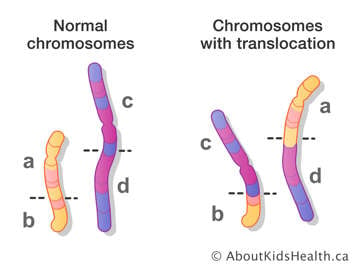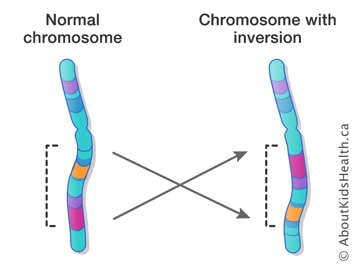There are 8 different subtypes of acute myeloid leukemia (AML). When your child is diagnosed with AML, doctors do a bone marrow aspirate test to determine the subtype.
How your child's AML subtype is determined
After taking a sample of your child’s marrow, lab specialists look at two different biological features: the type of blood cell involved, and the chromosomes.
The type of blood cell that has become cancerous
AML occurs when the DNA inside a young blood cell (myeloid cell) in the bone marrow changes so that it cannot develop into a mature blood cell. Cancerous myeloid cells are also called "leukemic myeloblasts."
Normally, myeloid cells develop into different type of blood cells. These include:
- monocytes, which develop further into white blood cells called macrophages. These cells help our body fight infection.
- erythrocytes (red cells)
- platelets
AML can occur in any one of these cell types.

Abnormal chromosomes
Chromosomes are long lengths of DNA inside cells. In a healthy cell, there are normally 46 copies of chromosomes. There are two copies of each chromosome. Each pair is numbered 1 through to 23.


Abnormalities in chromosomes can cause AML. These abnormalities include:
- Chromosome translocation, which happens when a part of a chromosome separates itself and sticks onto another, unrelated chromosome.
- Chromosome inversion, which happens when part of a chromosome turns upside down.
Both processes produce new chromosomes that express genes in different ways, and can lead to AML.
What are the AML subtypes?
The older French American British (FAB) classification system subdivided AML according to the type of cell that becomes cancerous. This system classified AML into 8 different subtypes, ranging from AML M0 to M7.
The World Health Organization (WHO) updated its classifications of AML in 2016 based on genetic changes in the leukemia cells, including:
- AML with recurrent genetic abnormalities
- AML with myelodysplasia-related features
- Therapy-related myeloid neoplasms
- AML, not otherwise specified
- Myeloid sarcoma
- Myeloid proliferations related to Down syndrome:
- Transient abnormal myelopoiesis (TAM)
- Myeloid leukemia associated with Down syndrome.
- Blastic plasmacytoid dendritic cell neoplasm (BPDCN).
Why is it important to know your child’s AML subtype?
Your child’s AML subtype helps doctors understand how best to treat the disease. It also predicts the likely prognosis of your child’s leukemia.
All the subtypes of AML follow similar treatment protocols, except subtype M3 or APL.
